Dawson Creek Disappointments
After nearly four months in the wilds of Canada and Alaska, we knew we’d be in for some “culture shock” when we drove into populated areas again. But somehow, we still weren’t prepared for Dawson Creek. After all, this is Mile Zero of the fantastic Alaska Highway, the mesmerizing adventure that we’ve been experiencing for so many weeks and miles. This is where IT ALL BEGAN. But it’s just a town, and not that pretty a town for that matter.
To be fair about it, we didn’t give it the best chance to look good. Our entry was on a soggy, dripping day with drenching rains and low ceilings. Coming in from the north, the town looked like some kind of science-fiction movie set about how civilization has assassinated Nature. Truly, there is not much Nature to be seen. The view through our rain-spotted windshield is of dull gray structures, bustling trucks, plumes of steam from processing plants, and a stern phone-number reminder from Crimestoppers.

The town has what you’d expect of a 17,000 population center – stores, gas, services. The visitor center is sub-par; we’ve seen much nicer in towns of 1,500. A much noted highlight, the Grain Silo Art Center, is closed for repairs. The “train museum” is two rooms off the visitor center. Local industry makes this town run, not tourism. Maybe they’re just used to everyone passing-through, on their way to experience the Big Road.
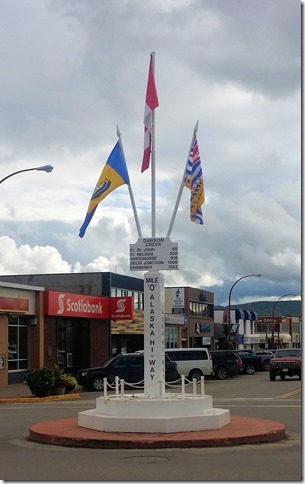 The Mile Zero post is a block of the present highway. I don’t know if that was the original location, or just a convenient one. It’s the place where the Highway started on its trek to Alaska. (Of course, the road was built from both ends; it also “started” at Delta Junction up in Alaska. The finishing point was in the middle, very near one of our camps. But all that’s not nearly as sensational as Mile Zero.)
The Mile Zero post is a block of the present highway. I don’t know if that was the original location, or just a convenient one. It’s the place where the Highway started on its trek to Alaska. (Of course, the road was built from both ends; it also “started” at Delta Junction up in Alaska. The finishing point was in the middle, very near one of our camps. But all that’s not nearly as sensational as Mile Zero.)
The advent of the Alaska Highway, especially poignant as it was ushered in by war-time conditions, somehow seems to make the point of origin very special – – – certainly more special than the town which existed before the Highway, and is remarkable in no other particular way.
There is a very nice presentation right across from the Mile 0 post, called the Alaska Highway House. It has some photos and memorabilia of the construction of the Highway. I snapped a few photos of the displays which I thought were particularly evocative of the building of the Road.
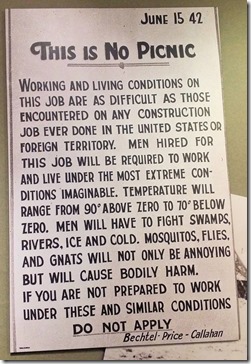 This was a recruiting poster.
This was a recruiting poster.
A nice overview of the overall route and regions.
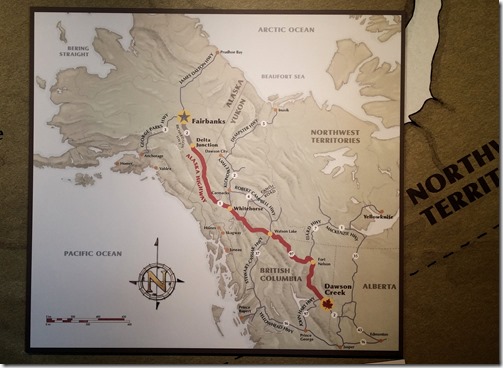
Comment about the areas where the Road had to be built.
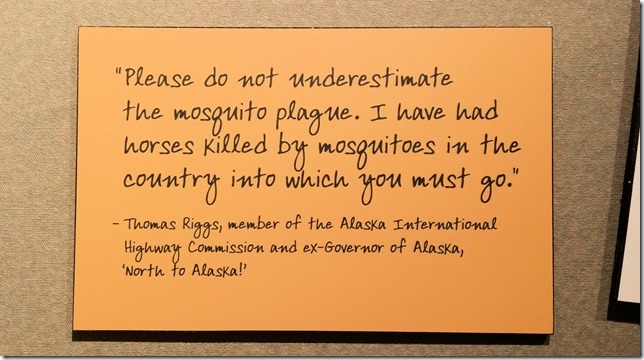
A shot of the same milepost, back in 1942-3. They were using Greyhound Buses (chartered) to transport military and civilian workers to the working points – but you couldn’t buy a ticket yet.
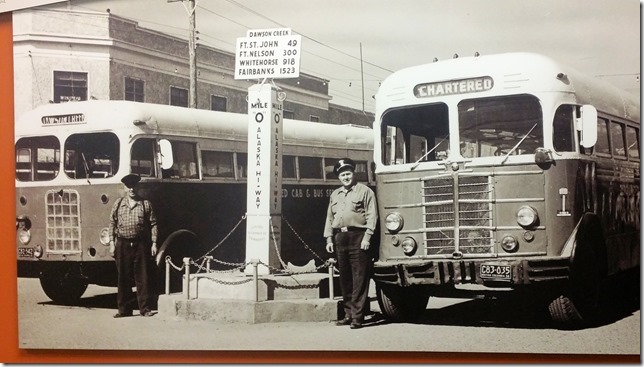
A reminder to early adventurers of the rigors imposed by the Highway.
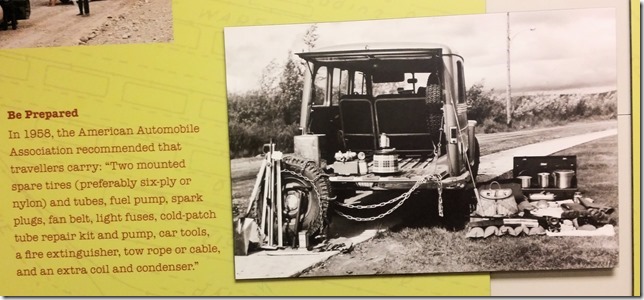
It was good for us to re-visit the massiveness of the enterprise that created this deservedly fabled road, and we were grateful for the one last thought-provoking review. Then, we departed the Alaska Highway House, gave a last look at Milepost 0, left the Alaska Highway behind us and drove out of the town where it all started. We headed south, and only a couple of miles from town, the harsh industrial countryside smoothed out into agricultural fields.

We settled into a plain-Jane RV park at Pouce Coupe, to map out our next few days. We’ll be moseying down highway 40 (Bighorn Highway) and meeting up with friends in or near Jasper National Park. But we will be thinking about the Alaska Highway (always the Alcan to us) for a long time to come.

Hi Greg – Good to be able to read your travelog today…was totally out of commission yesterday (Wed). As usual, good story & good pictures. More about my computer when I talk to you soon. Love, Mom
I sympathise with you, leaving Alaska behind. We strongly remember how “gutted” we were to drive into civilisation, seeing fields, horses, fences, and the usual ‘lead in’ to a town, which you dont experience in Alaska, where it seemed to be nothingness then a small town, then nothingness again! I hated to close The Milepost! What a great publication. Thanks for all your great stories.